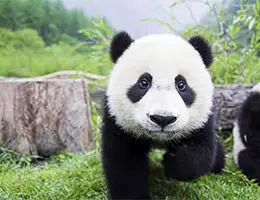 The panda bear is a mammal that lives in mountainous and forested areas of China . It is a plantigrade species (since, when moving, it rests the entire sole of the hands and feet on the surface) that is characterized by the combination of black hair on the ears, face, shoulders and legs. legs and white hair on the rest of the body.
The panda bear is a mammal that lives in mountainous and forested areas of China . It is a plantigrade species (since, when moving, it rests the entire sole of the hands and feet on the surface) that is characterized by the combination of black hair on the ears, face, shoulders and legs. legs and white hair on the rest of the body.
With the scientific name Ailuropoda melanoleuca , the panda belongs to the family group of ursids or bears , according to various scientific studies. However, long ago the panda used to be placed among the procyonids or raccoons .
The panda bear's diet is based on bamboo , a grass plant. Anyway, pandas are mammals and also consume insects, fish and small mammals.
It is estimated that there are just over 1,800 pandas living in the wild , to which we must add about two hundred specimens in captivity . Due to the destruction of its habitat , the high mortality of offspring and the reduced birth rate, the species is considered at risk of extinction .
Pandas are very popular thanks to their appearance. That is why the nature protection organization World Wildlife Fund ( WWF ) has a panda as its logo .
Emerged in the 1960s , this NGO was inspired by Chi-Chi , a panda at the London Zoo, for the development of its graphic representation. This specimen was very famous in the United Kingdom and was chosen as a symbol of the animal and environmental cause.
Let's look at some curiosities about pandas that may even help us understand why they were not initially considered part of the bear family:
* Unlike other bear species, the panda does not hibernate . The main reason for this particularity is that it is considered an animal with a subtropical climate, but it is also influenced by the fact that it feeds on bamboo, with rare exceptions on small rodents and birds, sources from which it cannot obtain enough fat to survive. accumulate and endure months of inactivity;
 * one of the reasons why the nature protection organization uses the image of the panda for its logo, beyond the almost magnetic attraction that this species provokes in the public, is that it only requires the use of black ink, and this reduces the production costs of advertising material;
* one of the reasons why the nature protection organization uses the image of the panda for its logo, beyond the almost magnetic attraction that this species provokes in the public, is that it only requires the use of black ink, and this reduces the production costs of advertising material;
* In their first years of life, pandas usually feed on their mothers' feces;
* The first panda bear to be born in captivity was in China. Some time later, the second was born in Mexico. To help control the population of these animals, each calf born outside of China is sent there as soon as possible;
* Regarding the personality of the panda bear, we can say that it is usually described as a peaceful and shy being , far from the ferocity with which it is generally associated with other species of bears. It is perhaps because of this trait of his that, added to his beauty, people consider him such an adorable animal;
* given the risk situation in which this species finds itself, attempts to enhance its reproduction know no limits. In addition to captive breeding, some specialists feed them diets designed to stimulate them sexually, give them Viagra or even show them videos of other pandas having sex, as hard as it is to believe;
* In the mid-20th century, baby pandas were often given as gifts in China as a token of goodwill . Needless to say, this practice is absolutely prohibited today.
